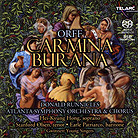April 2002
Donald Runnicles and the Atlanta Symphony Orchestra do a superb job with an interpretation very much in the standard mold. The vocals and choral performances are also quite well done, with standout performances turned in by baritone Earle Patriarco and the Gwinnet Young Singers. Not that I don’t completely enjoy contributions by tenor Stanford Olsen and soprano Hei-Kyung Hong -- I do. It’s just that they don’t quite measure up to the remarkable efforts of John Aler and Sylvia McNair on the (stereo) reference for this piece: RCA’s Red Seal [09026-61673-2] recording of the Saint Louis Symphony Orchestra and Chorus with Leonard Slatkin at the helm. The Telarc multichannel hybrid SACD features a stellar recording, rich in dynamics and color. The new high-resolution format gives the chorus a heightened presence through the more sharply focused presence of each voice within the mass. This new focus also serves to further sharpen microdynamics. Drum strikes, as just one example, are remarkably delineated with a lightening-fast attack. Triangles hover in mid-air with shimmering presence, as the new format seems to imbue the highs with new transparency and delicacy. The mix is tasteful, utilizing the surround channels properly, which means that they are restricted to the reproduction of hall ambience (which they contribute in spades). There's no middle-of-the-stage perspective or other silliness here -- excellent. Bass drum and choral voices can clearly be heard resonating throughout the hall in a completely natural way, convincingly placing the listener smack-dab in the middle of the venue. The center channel is also fully and properly utilized. Some engineers try to get only a little bit pregnant through their omission of the center channel, which restricts the listener to a very small sweet spot. What a waste. You should be able to get up and walk about the room and get the sensation of walking about the recorded venue. By taking full advantage of the multichannel format, Telarc ensures a fully developed soundstage for each listener. This is a large part of what multichannel listening should be about and it’s what this superb performance of Carmina Burana deserves. GO BACK TO: |
 Orff - Carmina Burana
Orff - Carmina Burana  Long a crowd-pleasing concert staple, Carmina Burana
takes the listener on a roller coaster ride through the cyclic highs and lows imposed on
man by fate. Linked together by recurring themes of love, lust, debauchery, dice and
drink, all of the hedonistic pleasures are given their due in a work that bears a striking
stylistic kinship to those of Stravinski and Prokofiev. Carmina Burana is a bombastic and
exciting piece, executed by an orchestra often running at full-tilt, fortified by a full
chorus, punctuated by solemn and affecting solo vocal efforts. The contrasting flavors
give the piece its emotional appeal. First-time listeners will no doubt recognize several
portions of the work borrowed for the Highlander series of films, not to mention
the occasional butter or beer commercial -- but don’t let that hinder you; every once
in a while, even Madison Avenue recognizes a good thing when it hears it.
Long a crowd-pleasing concert staple, Carmina Burana
takes the listener on a roller coaster ride through the cyclic highs and lows imposed on
man by fate. Linked together by recurring themes of love, lust, debauchery, dice and
drink, all of the hedonistic pleasures are given their due in a work that bears a striking
stylistic kinship to those of Stravinski and Prokofiev. Carmina Burana is a bombastic and
exciting piece, executed by an orchestra often running at full-tilt, fortified by a full
chorus, punctuated by solemn and affecting solo vocal efforts. The contrasting flavors
give the piece its emotional appeal. First-time listeners will no doubt recognize several
portions of the work borrowed for the Highlander series of films, not to mention
the occasional butter or beer commercial -- but don’t let that hinder you; every once
in a while, even Madison Avenue recognizes a good thing when it hears it.